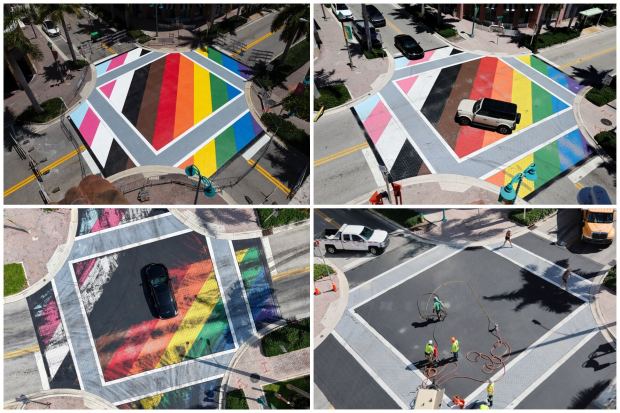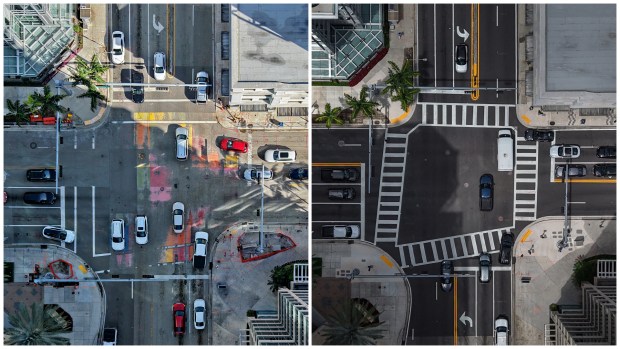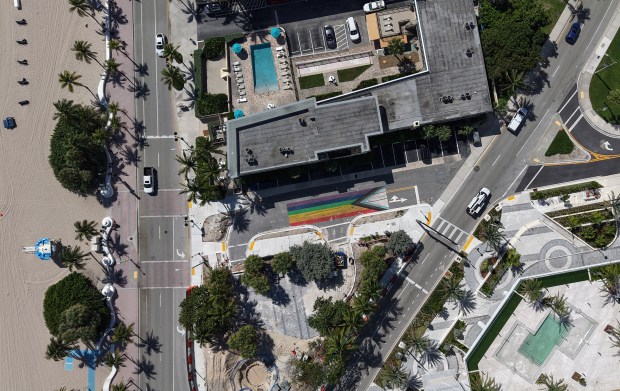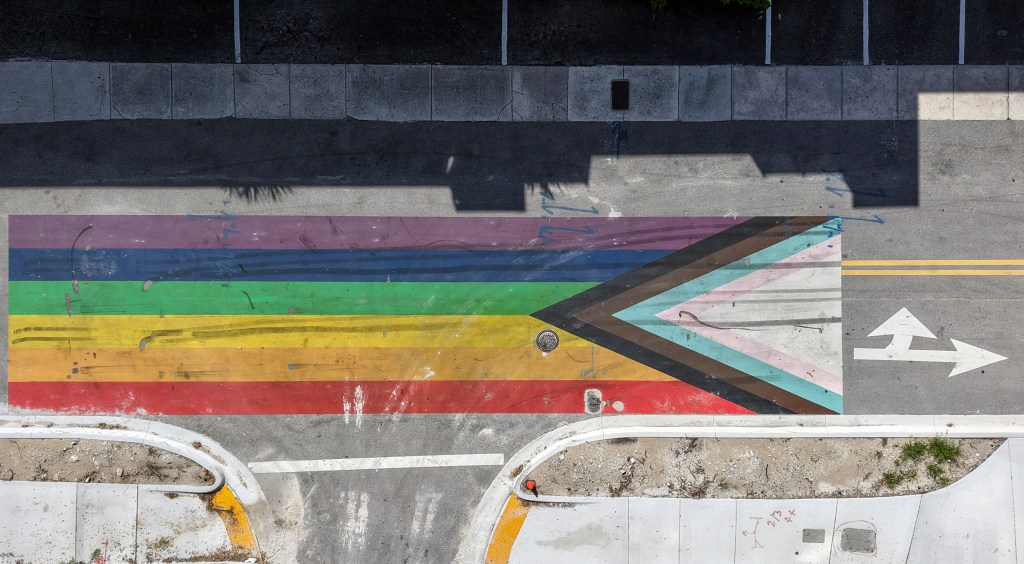One by one, rainbow crosswalks in cities across the Sunshine State are turning black.
But Fort Lauderdale has not given up its legal fight to save pride street art and colorful crosswalks amid a statewide crackdown that’s made headlines nationwide.
“We are the last man standing,” Fort Lauderdale Commissioner Steve Glassman told the South Florida Sun Sentinel. “This is an issue where you have to stand up for yourself. If we don’t stand up now, when do we stand up?”
The crackdown that began in August under the watch of Gov. Ron DeSantis has led to the removal of street art from Key West to Jacksonville.
In late August, DeSantis criticized Key West and Delray Beach for vowing to fight the state order.
“It’s like they think that they should just be a law unto themselves,” DeSantis said at the time. “You’re always gonna have the Key Wests of the world that are going to virtue signal. That’s just what they do.”
In response to the initial public outcry, state transportation officials argued that street art is distracting and can pose a risk to drivers. Defenders say the opposite, arguing that the vibrant designs actually help prevent accidents by slowing down traffic.
Critics say the state’s new edict is a thinly veiled attack on the LGBTQ community, just another pointed arrow launched in the country’s ongoing culture war.
One of those critics includes Fort Lauderdale Mayor Dean Trantalis.
“This is a culture war — let’s call it what it is,” he told the Sun Sentinel in August, soon after the crackdown began.
Fort Lauderdale’s pride flag was painted on Sebastian Street as a tribute to the large LGBTQ community that frequents that area of the beach, Trantalis noted.
In response to critics who say Fort Lauderdale is taking on a fight it can’t win, Trantalis argues the city will be able to make a strong case for home rule when it comes to street art.
“Right now we are submitting our position to the courts,” Trantalis said, referring to the city’s legal battle with the state. “In the meantime, we are open to discussing this with the state to see if we can come up with a compromise. In the meantime, we are still moving forward.”
 Delray Beach’s LGBTQ street display, shown top left, debuts in June 2021, at Northeast Second Avenue and Northeast First Street. At top right, a car crosses over the display on Aug. 18, 2025. Bottom left, black paint remains smeared after the state tried to remove the display on Sept. 9, 2025. Bottom right, workers return Sept. 10, 2025 to remove the street art. (South Florida Sun Sentinel photos)
Delray Beach’s LGBTQ street display, shown top left, debuts in June 2021, at Northeast Second Avenue and Northeast First Street. At top right, a car crosses over the display on Aug. 18, 2025. Bottom left, black paint remains smeared after the state tried to remove the display on Sept. 9, 2025. Bottom right, workers return Sept. 10, 2025 to remove the street art. (South Florida Sun Sentinel photos)
Elected officials in Delray Beach, Miami Beach and Key West initially seemed ready to do battle in court, but have since dropped the fight.
In Miami Beach, the iconic rainbow crosswalk on Ocean Drive was removed on Oct. 5.
In Delray Beach, state crews sandblasted the city’s rainbow-colored pride display at Northeast First Street and Northeast Second Avenue on Sept. 10.
In Key West, a resolution that would have taken the fight to court was voted down by the City Commission on Sept. 3. Six days later, state crews removed the city’s rainbow crosswalk at Duval and Petronia streets.
In a letter dated Aug. 21, the state ordered Fort Lauderdale to remove LGBTQ-themed pride art on Sebastian Street along with three other sites. If the pavement markings were not gone by Sept. 4, they would be removed by the state, the letter warned.
“You are further notified that if the markings are removed by the Department, all costs associated with the removal will be assessed against the city of Fort Lauderdale,” the letter said. “Please note that the Department will pursue withholding of state funds as permitted by the law should the City of Fort Lauderdale decide not to comply.”
On Aug. 29, the state added seven more street art locations to the list. One intersection was already paved over months ago but somehow made the list.
On Sept. 4, Fort Lauderdale filed a petition for a formal administrative hearing before the Florida Department of Transportation. A state hearing officer denied the request during an informal proceeding held in Orlando on Sept. 15. Four days later, the same hearing officer ordered the removal of every single street art design in Fort Lauderdale. That same day, the city filed a notice to appeal the FDOT order with the Fourth District Court of Appeals.
 The intersection of Las Olas Boulevard and Southeast Third Avenue in downtown Fort Lauderdale is seen on March 6, 2025, left. It was paved over months ago, on right, but somehow wound up on a list of street art sites the state wants removed. (Amy Beth Bennett/South Florida Sun Sentinel)
The intersection of Las Olas Boulevard and Southeast Third Avenue in downtown Fort Lauderdale is seen on March 6, 2025, left. It was paved over months ago, on right, but somehow wound up on a list of street art sites the state wants removed. (Amy Beth Bennett/South Florida Sun Sentinel)
Fort Lauderdale is currently engaged in four separate but related legal processes, spokeswoman Ashley Doussard told the Sun Sentinel.
Here’s a quick breakdown of the city’s legal battle on all four fronts:
First, Fort Lauderdale has filed a notice of appeal with the Fourth District Court of Appeal and has provided notice to the state Department of Transportation.
Second, the city has a petition pending before the state Division of Administrative Hearings. A hearing is scheduled for Jan. 13, 2026, at 9:30 a.m. in Tallahassee.
Third, a judge in the state’s 17th Judicial Circuit Court granted an order preserving the status quo until both parties can be heard on the city’s request for declaratory and injunctive relief.
Fourth, the state Department of Transportation has filed a notice of appeal with the Fourth District Court of Appeal of the order preserving status quo.
Miami Beach voluntarily dismissed its petition challenging the state’s order to remove its pride street art on Oct. 8, according to a memo written by Fort Lauderdale Interim City Attorney D’Wayne Spence.
“The city attorney of Miami Beach believes that this has become a losing battle and that it would be imprudent to spend additional resources,” Spence wrote. “Consequently, Miami Beach will not pursue further legal action at this time. The city of Fort Lauderdale’s petition is now the sole challenge to the rule before DOAH (Division of Administrative Hearings) to my knowledge.”
Across the Sunshine State, several cities voluntarily removed their street art after the state ordered them to do so.
In some cases where cities balked at the order, crews working for the Florida Department of Transportation removed the street art — sometimes in the wee hours of the night.
In Orlando, a rainbow crosswalk honoring the 49 victims of the Pulse Nightclub shooting was painted over in the middle of the night in August.
 An aerial view of a rainbow street art mural that was painted in 2023 on Sebastian Street in Fort Lauderdale. The city is in the midst of a legal battle with the state to save 10 street art designs, including this one. (Amy Beth Bennett/South Florida Sun Sentinel)
An aerial view of a rainbow street art mural that was painted in 2023 on Sebastian Street in Fort Lauderdale. The city is in the midst of a legal battle with the state to save 10 street art designs, including this one. (Amy Beth Bennett/South Florida Sun Sentinel)
In Fort Lauderdale, activists were on high alert waiting for the state to send crews into town in the middle of the night to paint over the city’s rainbow street art.
Bill Brown, a community leader who lives near Sebastian Street, sounded the alarm one Saturday in late September when he thought state crews were painting over the pride art. Brown sent a quick text to the city manager. In the end, it turned out to be men at a nearby construction site pressure cleaning the street.
Brown said he understands the city’s decision to fight the state but worries about the legal costs.
“I know some of the commissioners are fighting it to stand up for the LGBTQ community,” said Brown, who is openly gay. “However, if we’re not going to win the legal battle, how much money is it going to cost?
“I don’t see it being resolved in the state’s appellate court. Are they willing to take it to the U.S. Supreme court? And if they did, I don’t think they’d win.”
Fort Lauderdale resident Charlie King, a frequent critic of City Hall, said he thinks Fort Lauderdale has picked a fight it can’t win.
“I think it’s a waste of taxpayer dollars,” King said. “It sounds like the state has control over this. If they want to display rainbow art, it doesn’t have to be in a crosswalk. It can be in a park where we won’t have to ask anyone’s permission.”
Glassman argues the city has to take a stand.
“For me, it’s really about home rule,” he said. “Do we have control over our own streets? Are we able to express ourselves, whether it’s street art or anything else?”
Glassman said he understands why other cities have given up the fight in the face of threats from the state to take away funding.
“Is that even legal?” Glassman asked. “The courts need to decide if it’s legal for the state to extort until it gets its way. Let’s do this test (in court) and see where we stand and where our rights are and how much control we have over our own city.”
Susannah Bryan can be reached at sbryan@sunsentinel.com. Follow me on X @Susannah_Bryan

